Rosengård
Rosengård (literally "Rose Manor") was a city district (Swedish: stadsdel) in the center of Malmö Municipality, Sweden. On 1 July 2013, it was merged with Husie, forming Öster.[1] In 2012, Rosengård had a population of 23,563 of the municipality's 307,758.[2] Its area was 332 hectares.[3]
Rosengård is often incorrectly referred to as a suburb, although the area is located centrally in Malmö, neighbouring the former city district Centrum. Long a destination for immigrants, 86% of the population had some foreign ancestry in 2008.[4]
History
Most of Rosengård was built between 1967 and 1972 as a part of the Million Programme although some parts, such as the mansion in Herrgården, and Östra kyrkogården, are older. Rosengård is to a high degree populated by minorities. In 1972, the percentage of immigrants was around 18%, with the majority of inhabitants being working-class people from rural Sweden. Since 1974, there has been a white flight out of the suburb as more immigrants were assigned there. By 2012, the figure for those of immigrant background was given as 86%.[5]
Violence
Rosengård has also been the place for several violent clashes between gangs[6] and between the resident youths and authorities.[7] Fire crews and ambulance personnel have also been threatened and attacked, as well as the police.
In June 2011, shots were fired at the lower floor of the police station in Rosengård. Nobody was arrested.[8]
In December 2008, riots occurred as youngsters confronted the police in which cars, wagons, kiosks, building sheds, recycling stations, and bicycle sheds were set ablaze. The background to the riots was the eviction of a local mosque. The riot was the most violent yet seen in a suburb in Sweden. The riot finally ended when police forces from Gothenburg and Stockholm were sent in.[9]
In its December 2015 report, the Swedish Police Authority placed the southern half of the district in the most severe category of urban areas with high crime rates.[10]
In the summer of 2016, Malmö in Sweden suffered a wave of vehicle fires where 70 vehicles were destroyed in a series of attacks.[11] Around half the fires took place in Rosengård.[12]
In 2016, after a criminal family had been evicted in an effort by the housing company to reduce crime, the office of the housing company was subjected to three bomb attacks.[13]
Film
The 2005 documentary ”Utan gränser – en film om idrott och integration” (Without Borders - A Film About Sports and Integration) was shot in Rosengård, and is a film described by Swedish newspaper Aftonbladet as "a documentary on how to succeed with integration" of migrants into Swedish society.[14] Osama Krayem, one of the protagonists, later went on to become one of the 2016 Brussels bombings perpetrators.
Neighbourhoods
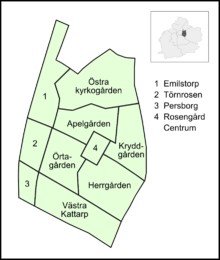
The neighbourhoods of Rosengård were:
- Apelgården
- Emilstorp
- Herrgården
- Kryddgården
- Persborg
- Rosengård Centrum
- Törnrosen
- Västra Kattarp
- Örtagården
- Östra kyrkogården
Malmö Mosque is located nearby. It is situated a few hundred metres from the church in Västra Skrävlinge.
Rosengård Centrum is a shopping mall with several stores, including one of Sweden's largest grocery stores (City Gross). Zlatan Court, a football field sponsored by the football player Zlatan Ibrahimović, is situated in the area too.
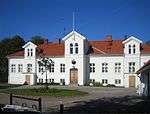 The mansion house.
The mansion house. Tower block buildings in Rosengård.
Tower block buildings in Rosengård. Malmö Mosque.
Malmö Mosque. Västra Skrävlinge Church.
Västra Skrävlinge Church. Central Rosengård, near Rosengård Centrum.
Central Rosengård, near Rosengård Centrum. Zlatan Court.
Zlatan Court.
Places of worship
According to the Swedish Defence University reports in 2009 and 2018, In Rosengård there are a number of Islamic prayer rooms (Swedish: källarmoskéer) spreading a radical salafist ideology.[15]
Demographics
| Year | Pop. |
|---|---|
| 1961 | 5,250 |
| 1971 | 23,112 |
| 1981 | 18,006 |
| 2001 | 21,027 |
| 2004 | 21,526 |
| 2007 | 21,955 |
| 2011 | 23,653 |
| 2012 | 23,563 |
In 2007, 60% were born outside of Sweden.[16] In 2008, 86% of the population was of foreign background.[4]
The ten largest groups of foreign-born persons in 2010 were:[17]
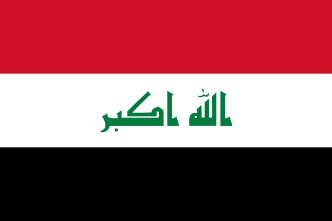
.svg.png)
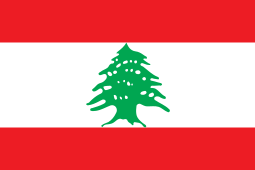

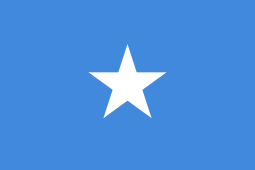


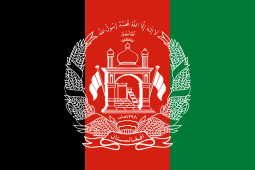


Social issues
Unemployment and education are two major issues in the area. Only 38% of the population in Rosengård are employed and 60% complete elementary school, compared to a citywide average (inclusive Rosengård) of 80%, indicating that in the rest of the city, about 100% finish elementary school.(2008) [4]
Notable people
- Zlatan Ibrahimović
- Osama Krayem
- Yksel Osmanovski
- Labinot Harbuzi
- Goran Slavkovski
- Ilir Latifi
- Rebstar
- Saint
- Dollar Bill, hip hop group
- Pinar Yalcin
References
- "Nystart för ett bättre Malmö". Malmö Municipality (in Swedish). 27 June 2013. Archived from the original on 1 February 2014. Retrieved 19 January 2014.
- "Befolkningsbokslut Malmö 2012" (PDF). Malmö Municipality (in Swedish). 17 June 2013. Archived from the original (PDF) on 1 February 2014. Retrieved 19 January 2014.
- "Blad1 (Areal)". Malmö Municipality (in Swedish). Archived from the original on 2 February 2014. Retrieved 19 January 2014.
- "Herrgården - värst utsatta området i Rosengård". Dagens Nyheter. 20 December 2008. Retrieved 19 January 2014.
- "Another side of Malmö's infamous Rosengård". The Local. Malmö.
- "Malmöpolisen fruktar gängkrig i Rosengård". Expressen.
- "Nye opptøyer i Malmö". Dagbladet. 23 November 2009.
- Radio, Sveriges. "Shots fired at Rosengård police station - Radio Sweden". sverigesradio.se. Retrieved 15 August 2018.
- http://www.smp.se/nyheter/sverige/article1046376.ece
- Utsatta områden - sociala risker, kollektiv förmåga och oönskade händelser (PDF). Police in Sweden - Nationella Operativa Avdelningen - December 2015. p. 29. Archived from the original (PDF) on 19 August 2016.
- "Malmö's wave of car burnings continues". 12 August 2016. Retrieved 15 August 2018.
- "Malmö sees spike in summer car burnings". 10 August 2016. Retrieved 15 August 2018.
- Radio, Sveriges. "Bomberna i Rosengård - P1 Dokumentär". sverigesradio.se (in Swedish). Retrieved 15 August 2018.
- Nilsson, Christoffer; Melin, Eric (15 April 2016). "Swedish terror suspect was in movie about successful integration - Terrormisstänkt svensk var med i film om lyckad integration". Aftonbladet (in Swedish). Retrieved 17 April 2016.
As an eleven-year-old Osama Krayem participated in a documentary on how to succeed with integration.
- Magnus Ranstorp, Filip Ahlin, Peder Hyllengren, Magnus Normark. Mellan salafism och salafistisk jihadism - Påverkan mot och utmaningar för det svenska samhället (PDF). 2018: Swedish Defence University. pp. Section 4.4.1.CS1 maint: multiple names: authors list (link) CS1 maint: location (link)
- http://www.malmo.se/download/18.10d69f8c11884193e5d80003762/20.ROSENG%C3%85RD.pdf
- "Malmöbor födda i utlandet. 1 januari 2010". Malmö Municipality (in Swedish). 1 January 2010. Archived from the original on 5 March 2012. Retrieved 19 January 2014.
External links
| Wikimedia Commons has media related to Rosengård. |